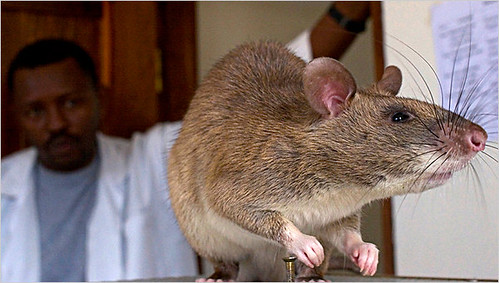Potentially, anyway. One of the challenges facing infectious disease medicine in the developing world is the cost of diagnosis: diagnostic tests are often invented in wealthy countries with access to expensive equipment and supplies (and, in those countries, these don't seem very expensive at all). Tuberculosis (TB) is difficult to diagnose in wealthy countries, and the inability to afford expensive diagnostics in the developing world--where most TB cases occur--only further compounds the problem.
So this report of a potentially cheap and more effective way to figure out if someone has TB provides some hope:
Researchers have found a new way of testing for tuberculosis that is fast, cheap and widely available: large rats that can smell the bacteria in a sputum sample.
There are expensive and complicated laboratory tests for tuberculosis, and the World Health Organization recently endorsed a new machine that can give accurate results in under two hours. But the device costs $17,000, and each test requires a $17 cartridge.
Whatever else can be said about them, rats are cheaper.
Today, the most commonly used detection method in developing countries is smear microscopy. This 100-year-old technique involves collecting sputum, dyeing it with a substance that colors only Mycobacterium tuberculosis, the germ that causes TB, and examining the sample under a microscope.
The technique can be used in places where facilities are minimal, but it is not very sensitive -- unless there is a high concentration of them, the bacilli are easy to miss, and that results in as many as 60 to 80 percent of positive cases going undiagnosed....
Writing in the December issue of The American Journal of Tropical Medicine and Hygiene, Dr. Poling and his colleagues report a test of the rats using samples that were confirmed by laboratory culture as either positive or negative.The animals' sensitivity -- that is, their ability to detect the presence of tuberculosis -- ranged as high as 86.6 percent, and their specificity, or ability to detect the absence of the germ, was over 93 percent.
In another test that compared the rats' success to microscopy, the rats picked up 44 percent more positive cases.
Meet your diagnostic:

Sala Lewis/Reuters
Of course, you have to train the rats:
When the rats are about 8 weeks old, the trainers put sputum samples, positive and negative for tuberculosis, under "sniffing holes" in a specially designed cage.
When a rat spends at least five seconds at a positive sample, it is rewarded with peanuts and bananas. Eventually, the rats learn that a longer sniff at a positive sample gets a reward, and that negative samples are unproductive and should be skipped over quickly.
It remains to be seen how effective and reproducible this will be, but, if it works, these furballs could save lives.
- Log in to post comments

What does 'very unique' mean? Isn't unique a Boolean distinction?
That's not the problem. I was given TB by a stupid doctor vacinating me for the second time.
The real problem is the drugs, and in particular the taste. They are foul. Not even flavouring can cope with it. There is also the physical quantity that needs to be taken.
That's why people don't take them.
Nothing a rat can do that a dog cannot.
Dogs have other uses to so traing a dog to sniff out TB may be a better idea.
Yes, but dogs are much more expensive to keep than rodents. Remember that these people are looking for inexpensive diagnostic tools.
Rats and dogs use their noses for very different things. Dogs are bred and trained for tracking, and recently, drug sniffing.
Rats, as omnivores must use their noses regularly to determine wether or not something is good to eat. Presumably they'd also be better at identifying harmful bacteria. (It's also why they are so hard to poison effectively).
I don't know about you guys, but my dog will eat anything, including tin foil, plastic, rubber, wood and poop.
You can also keep a rat pretty happy in a cage, very low upkeep there
Everybody sing!
Hero rats, hero rats, fighting for mankind!
Rats are small, smart, and clean animals. They're easier to care for than dogs, and make quite pleasant pets (if you like rodents, that is.)
If I'd have known I could train the pet rats I had years ago to do neat things to help humans out... I probably still wouldn't have done it - I'm pretty lazy. But it's awesome that other people have been able to do it.
Hey guys, take it easy. I love dogs, but it's true, the rats are easiest to care them (like sinned34 said), also are cheaper, smaller, and very important: easy to reproduced them! and a very long etc. That's the reason to be the ideal model to study many diseases and their treatments, why not to detect them?
We have a taboo with the rats, because it's true, they are a plague (via the humans), and the vector of many diseases, but now they are working with us to, if you look at PubMed there are more of 2,399,498 studies in rats and roedents!
I'm no expert, but I heard someone mentioning that the bigger problem isn't even sputum analysis accuracy, much as we would like technology to solve our problems, but having to rely on sputum, which is annoying to collect (and heroRats would not solve this). I need to do more research on it, but throwing it out there in case anyone can point me in the right direction. But many things can be improved, certainly including treatment completion.